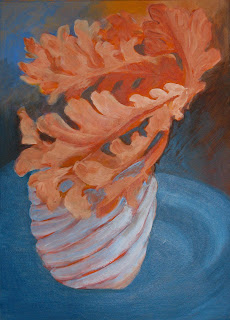Wednesday, March 13, 2013
An oak leaf retrospective
My March painting-in-progress includes a branch of dried oak leaves, not the first painting that oak leaves have inspired me to do. More about this new painting and the mystery tree that contributed the leaves in my next post (I hope), but first I thought I'd share the lineage of my current work.
I've always loved oak trees, their leaves which are most commonly deeply toothed, and the acorns that entice squirrels into their propagation efforts. There's lots of opportunity to indulge in leaf and acorn collecting hereabouts:-- the Quercus or oak species is one of the most widely distributed worldwide, and Vancouver has an abundance of different varieties, most of them introduced. I like the idea that oaks were sacred to the druids of my ancestral Ireland -- in fact, "druid" apparently means "knowers of the oak." (This is one of the less quirky ...quercky?...things you'll learn about druids if you go googling).
Oaks and acorns were embedded in my artistic consciousness by the mantra of my first great art teacher, Kimon Nicolaides, via his classic book The Natural Way to Draw, written before I was born and given to me by JT when we were Young Marrieds. In my first-ever studio, I concocted the first of my "Aphorisms" series from Nicolaides' counsel, which was given in the context of "What counts is continuous hard work, as much as talent."
When we first moved to the house that we left last year, I developed a long-term fascination with the shapes and shadows of houseplants against my studio window. Two squirrel-donated oak seedlings went into this early painting (c. 1986).
Some years later on an autumn sidewalk, I found a fallen branch of delicate oak leaves and used them in a composition experiment -- aiming to make an integrated painting from two horizontal bands. "Oak Leaves and Oyster Shells" (2003) was one of several paintings I took to my 2005 personal critique at Emily Carr art school. The instructor was initially dismissive, saying it was "almost two separate paintings," but then he viewed it a second time, deciding that the "rather hallucinatory oysters" gave it a certain appeal.
The huge oak tree at the corner of our old block always shed some abundantly leaved branches, and one of these stirred up "Dreams of Wild Botanists (warm)" (2005 -- and yes, there's a cool version which happens to be without oak leaves).
In the fall of 2008, as I daily took the bus to and from JT's rehab facility, I walked through two blocks strewn with the windfall of oaks with rounded leaves (coincidentally, just a block from where we live now). I brought some branches home in a specially constructed padded bag to protect them from the jostle of public transit. One of these branches had a supporting role in "That Time of Year" (2009).
Enthralled by the turns and grace of this particular branch, I placed it in a starring role in a small quick study, "Oak Leaf Dance" (2009).
Some First Nations used acorns as a dietary staple, and once long ago in Ontario, JT and I decided to give these a try. The trick is to boil and boil and boil again to remove the tannin, before toasting and grinding to make a kind of flour. Nothing to blog home about, as the saying goes -- but maybe by next post, I'll have produced instead a feast for the eyes. Fingers crossed!
Subscribe to:
Post Comments (Atom)









No comments:
Post a Comment